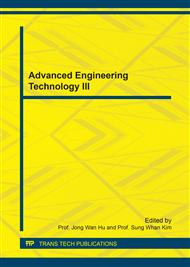[1]
L. J. Rather, S. Islam, M. A. Khan, F. Mohammad, Adsorption and kinetic studies of adhatoda vasica natural dye onto woolen yarn with evaluations of colorimetric and fluorescence characteristics, J. Env. Chem. Eng. 4 (2016) 1780–1796.
DOI: 10.1016/j.jece.2016.03.003
Google Scholar
[2]
E. Yi, J. Y. Cho, Color analysis of natural colorant‐dyed fabrics, Color Res. Appl. 33 (2008) 148-157.
DOI: 10.1002/col.20390
Google Scholar
[3]
R. Mongkholrattanasit, C. Saiwan, N. Rungruangkitkrai, N. Punrattanasin, K. Sriharuksa, M. Nakpathom, C. Klaichoi, Eco-dyeing of silk fabric with Garcinia Dulcis (Roxb. ) Kurz Bark as a source of natural dye by using the padding technique, J. Nat. Fiber. 13(01) (2016).
DOI: 10.1080/15440478.2014.984056
Google Scholar
[4]
R. Mongkholrattanasit, C. Saiwan, N. Rungruangkitkrai, N. Punrattanasin, K. Sriharuksa, M. Nakpathom, C. Klaichoi, Ecological dyeing of silk fabric with lac dye by using padding techniques, J. Text. I. 106 (2015) 1106–1114.
DOI: 10.1080/00405000.2014.976957
Google Scholar
[5]
M. Akkaya, S. Eyupoglu, The examination of the effects of quercus aegilops extract used as natural mordant on colourfulness features of natural dyeing. 2016 IEEE NW Russia Young Researchers in Electrical and Electronic Engineering Conference IEEE, (2016).
DOI: 10.1109/eiconrusnw.2016.7448133
Google Scholar
[6]
A. Kiumarsi, M. P. Gashti, P. Salehi, M. Dayeni, Extraction of dyes from Delphinium Zalil flowers and dyeing silk yarns, J. Text. I. 108 (2017) 66-70.
DOI: 10.1080/00405000.2016.1153865
Google Scholar
[7]
P. B. Tayade, R. V. Adivarekar, Extraction of Indigo dye from Couroupita guianensis and its application on cotton fabric, Fash. Text. 1 (2014) 1-16.
DOI: 10.1186/s40691-014-0016-3
Google Scholar
[8]
R. Mongkholrattanasit, C. Saiwan, C. Klaichoi, N. Rungruangkitkrai, P. Sasivatchutikool, UV-protection property of silk fabric dyed with natural indigo by using padding technique: A focus on effect of ferrous sulfate mordant, Appl. Mech. Mater. 804 (2015).
DOI: 10.4028/www.scientific.net/amm.804.217
Google Scholar
[9]
J. N. Chakraborty, R. B. Chavan, Dyeing of denim with indigo Indian, Indian J. Fibre Text. Res., 29 (2004) 100-109.
Google Scholar
[10]
A. Vuorema, P. John, M. Keskitalo, M. A. Kulandainathan, F. Marken, Electrochemical and sonoelectrochemical monitoring of indigo reduction by glucose, Dyes Pigments, 76 (2008) 542-549.
DOI: 10.1016/j.dyepig.2006.06.044
Google Scholar
[11]
R. Mongkholrattanasit, J. Kryštůfek, J. Wiener, M. Viková, Dyeing, fastness, and UV protection properties of silk and wool fabrics dyed with eucalyptus leaf extract by exhaustion process, Fibre Text East Eup. 19 (2011) 94-99.
DOI: 10.1080/00405001003722369
Google Scholar


